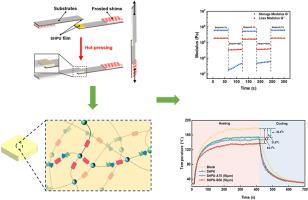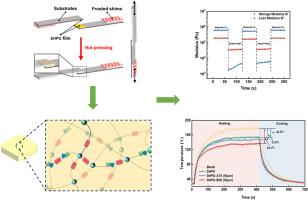热管理用可逆二硫键大豆油制备可自愈粘接聚氨酯
IF 4.5
2区 化学
Q2 POLYMER SCIENCE
引用次数: 0
摘要
导热聚合物是高热流密度器件的关键材料。以大豆油多元醇为原料合成了一种具有可逆二硫键的新型导热聚氨酯弹性体(SHPU)。这种弹性体在室温下表现出快速的自我修复能力。SHPU还表现出对各种基材的优异附着力,如钢,铜,铝,环氧树脂和聚氯乙烯,在钢基材上的附着力高达5.51 MPa。此外,在SHPU弹性体的基础上,加入了典型的填料氧化铝(Al2O3)和氮化硼(BN),制备了高导热复合材料,SHPU/BN复合材料的导热系数为2.31 W m-1 K-1。此外,嵌入填料的SHPU仍然保持着显著的自愈能力和附着力。SHPU的独特性能显示了它作为一种先进的导热聚合物基质的巨大潜力。这项研究为开发可靠和可持续的导热材料提供了新的见解。本文章由计算机程序翻译,如有差异,请以英文原文为准。


Self-healable and adhesive polyurethane from soybean oil with reversible disulfide linkages for thermal management
Thermally conductive polymers are crucial for high heat flow density devices. Herein, a novel thermally conductive polyurethane elastomer (SHPU) with reversible disulfide linkages was synthesized from soybean oil polyol (SOP). This elastomer exhibits rapid self-repairing capabilities at room temperature. SHPU also demonstrates superior adhesion to various substrates, such as steel, copper, aluminum, epoxy, and polyvinyl chloride, achieving a particularly high adhesion strength of up to 5.51 MPa on steel substrates. Additionally, based on SHPU elastomer, the typical fillers, alumina (Al2O3) and boron nitride (BN), have been incorporated to prepare highly thermally conductive composites, and achieving a high thermal conductivity of 2.31 W m−1 K−1 of SHPU/BN composites. Furthermore, SHPU embedded with fillers still maintain remarkable self-healing capability and adhesion. The unique properties of SHPU demonstrate its great potential as an advanced thermally conductive polymer matrix. This study offers new insights into the development of reliable and sustainable thermally conductive materials.
求助全文
通过发布文献求助,成功后即可免费获取论文全文。
去求助
来源期刊

Polymer
化学-高分子科学
CiteScore
7.90
自引率
8.70%
发文量
959
审稿时长
32 days
期刊介绍:
Polymer is an interdisciplinary journal dedicated to publishing innovative and significant advances in Polymer Physics, Chemistry and Technology. We welcome submissions on polymer hybrids, nanocomposites, characterisation and self-assembly. Polymer also publishes work on the technological application of polymers in energy and optoelectronics.
The main scope is covered but not limited to the following core areas:
Polymer Materials
Nanocomposites and hybrid nanomaterials
Polymer blends, films, fibres, networks and porous materials
Physical Characterization
Characterisation, modelling and simulation* of molecular and materials properties in bulk, solution, and thin films
Polymer Engineering
Advanced multiscale processing methods
Polymer Synthesis, Modification and Self-assembly
Including designer polymer architectures, mechanisms and kinetics, and supramolecular polymerization
Technological Applications
Polymers for energy generation and storage
Polymer membranes for separation technology
Polymers for opto- and microelectronics.
 求助内容:
求助内容: 应助结果提醒方式:
应助结果提醒方式:


